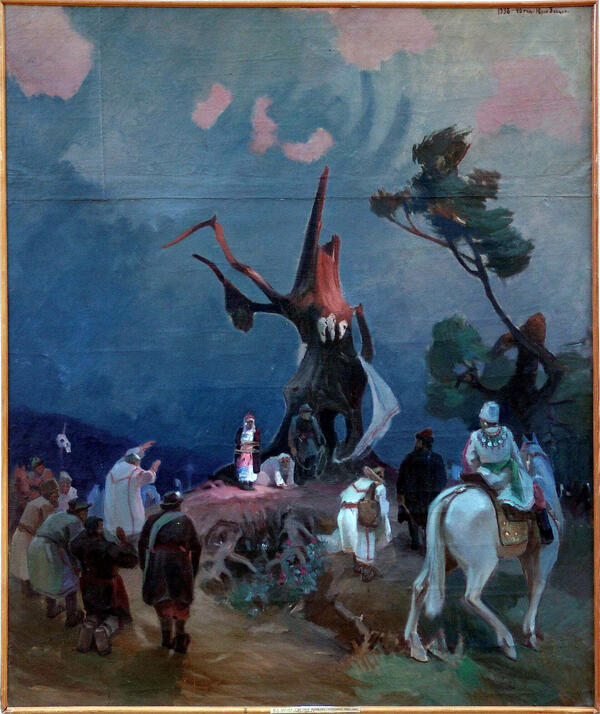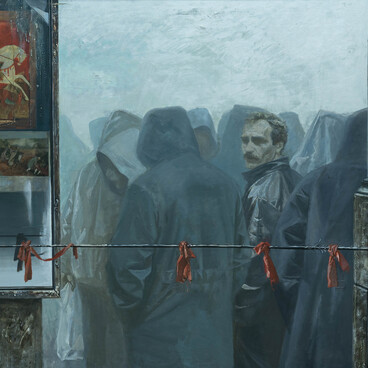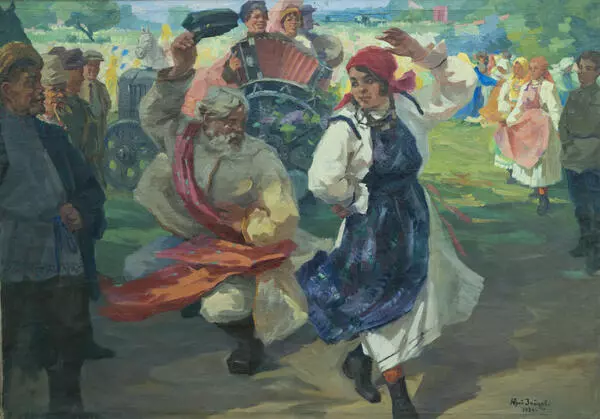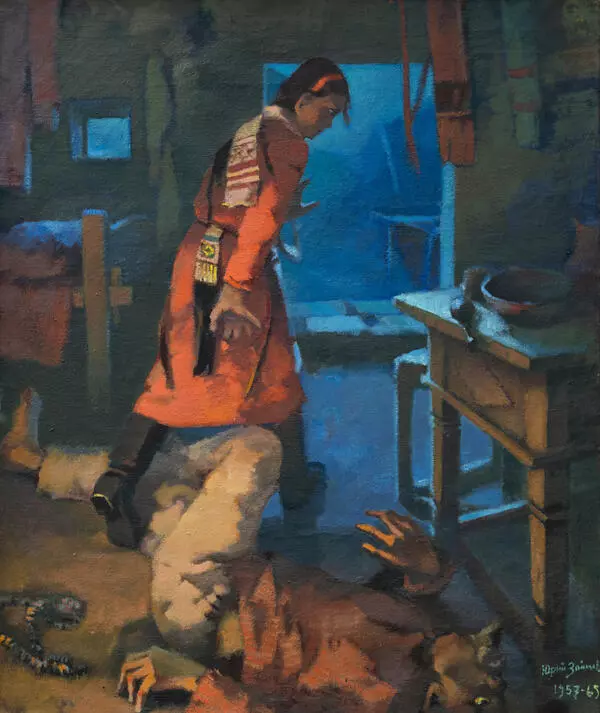Yury Zaytsev’s interest in the history of his native people was reflected in the paintings that he created based on the poem “Narspi” by Konstantin Vasilyevich Ivanov. The idea for this picture came to the artist in the early 1930s, however, he started to develop it only in 1939, when preparations for the celebration of the poet’s 50th anniversary began in the republic. For two years, the artist drew from nature in the Chuvash villages of Bashkortostan — Ivanov’s homeland — as well as made sketches and painted portraits.
At the anniversary exhibition dedicated to Konstantin Ivanov, Zaytsev presented a whole series of his works inspired by “Narspi”, arousing great interest in the general public and among art historians. One of these paintings is called “Kiremet”, which is based on the play “Aidar” by Pyotr Osipov. The plot of Sendier and Pinerbi’s love, tragically destroyed by Aidar, develops against the vivid historical and ethnographic backdrop of everyday life, customs, beliefs, and folklore of the Chuvash people in the 18th century. The composition, the rhythm of the alternating main and minor characters, the vibrant unsettling coloring of some shapes and the cold gloomy one of others produce the necessary emotional effect on the viewer.
The center of the composition shows the figure of the bride standing near the kiremet — a pagan deity who, according to the Chuvash, lived in old dry tree trunks. She is surrounded by frightened friends of the groom — the all-powerful rich man Aidar.
The evening afterglow casts cold reflections on the airy pinkish clouds, the white skulls of sacrificial animals, and the white veil and dress of the bride. In the light of the blue evening sky, the trees project their blue shadows on the grass, and the groom on a white horse rises formidably. He decides to sacrifice the disobedient Pinerpi. Although the facial expressions of those present cannot be discerned, the fear of some characters and the villainous assentation of others are expressed through their postures and gestures.
The artist did not seek to create an illustration for the literary work; instead, he used this national coloring and rite to compare the past and the present, to reflect upon reality through the lens of the plot that sheds light on the people’s folklore and history.
At the anniversary exhibition dedicated to Konstantin Ivanov, Zaytsev presented a whole series of his works inspired by “Narspi”, arousing great interest in the general public and among art historians. One of these paintings is called “Kiremet”, which is based on the play “Aidar” by Pyotr Osipov. The plot of Sendier and Pinerbi’s love, tragically destroyed by Aidar, develops against the vivid historical and ethnographic backdrop of everyday life, customs, beliefs, and folklore of the Chuvash people in the 18th century. The composition, the rhythm of the alternating main and minor characters, the vibrant unsettling coloring of some shapes and the cold gloomy one of others produce the necessary emotional effect on the viewer.
The center of the composition shows the figure of the bride standing near the kiremet — a pagan deity who, according to the Chuvash, lived in old dry tree trunks. She is surrounded by frightened friends of the groom — the all-powerful rich man Aidar.
The evening afterglow casts cold reflections on the airy pinkish clouds, the white skulls of sacrificial animals, and the white veil and dress of the bride. In the light of the blue evening sky, the trees project their blue shadows on the grass, and the groom on a white horse rises formidably. He decides to sacrifice the disobedient Pinerpi. Although the facial expressions of those present cannot be discerned, the fear of some characters and the villainous assentation of others are expressed through their postures and gestures.
The artist did not seek to create an illustration for the literary work; instead, he used this national coloring and rite to compare the past and the present, to reflect upon reality through the lens of the plot that sheds light on the people’s folklore and history.





